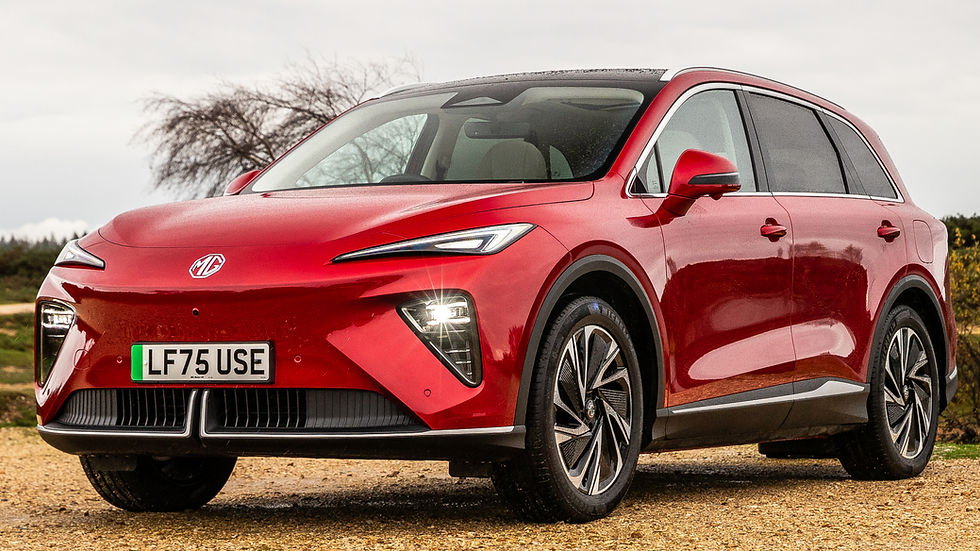This is the new 2024 Polestar 2 Facelift
- everything cars and more

- Jan 25, 2023
- 4 min read
Updated: Dec 10, 2023
Polestar is giving the 5-door electric performance fastback, Polestar 2, a major update. For the 2024 model year, the premium compact EV features a new high-tech front end that reflects the design language premiered by Polestar 3, substantial performance increases with all-new electric motors, even more powerful batteries[1], sustainability improvements and, for the first time in a Polestar, rear-wheel drive.
“Typically in the car industry, a facelift introduces superficial visual changes that often destroy the original intention of the car’s design theme. With the new model year Polestar 2, we rather went below the surface and upgraded substantial tech and mechanical components of the electric drivetrain. This is the best Polestar 2 yet, and with the updated front design with the new SmartZone, the best looking one, too,” says Polestar CEO, Thomas Ingenlath.
Polestar 2 first entered the highly competitive premium EV market in 2019, blending Scandinavian design and excellent usability with fun driving characteristics and a dedication to sustainability. It was the first car in the world to feature an infotainment system powered by Android Automotive OS with Google built-in, an experience that continues to evolve and lead the industry. This unique mix of qualities quickly made Polestar 2 a customer favourite, available in 27 markets globally and having surpassed the 100,000 unit production mark in late 2022.
High-tech design tweaks
The SmartZone makes its debut on Polestar 2, signifying the shift from breathing to seeing and reflecting the high-tech nature of Polestar vehicles. Like on Polestar 3, the SmartZone hosts some of the vehicle’s most important active safety features, including the front facing camera and mid-range radar.
The 20-inch forged alloy wheels in the Performance Pack have been updated to align Polestar 2 in its sportiest expression with that of Polestar 3.
New motors, refined ride and rear-wheel drive
Next-generation electric motors and inverters are fitted to all Polestar 2 variants, offering substantial increases in both efficiency and performance. Single-motor variants are now rear-wheel driven, powered by a newly developed permanent magnet motor and silicon carbide inverter. The new motor has a power output of up to 220 kW (increased from 170 kW) and is optimised for maximum efficiency and high torque (490 Nm, up from 330 Nm) to further increase the dynamic performance of the car. The 0-100 km/h sprint time has been reduced by as much as 1.2 seconds, down to 6.2 seconds.
The dual-motor version now has a rear-drive bias that increases driving pleasure and performance thanks to a completely re-balanced drivetrain setup and torque-ratio. The new rear motor is the primary drive source, supported on the front axle by a new asynchronous motor. This enables higher total system output of 310 kW and 740 Nm (increased from the original 300 kW and 660 Nm), vastly improved traction, greater overall efficiency and higher performance – 0-100 km/h is achieved in 4.5 seconds. Supporting efficiency gains, the front motor can now be disengaged completely when not needed. When the driver wants more power, the front motor re-engages instantly and seamlessly.
Up to 350 kW are available with the optional Performance Pack, and a 0-100 km/h sprint time as low as just 4.2 seconds. The increase in power, performance and driving enjoyment is also available to purchase as a downloadable over-the-air performance software upgrade for any eligible Long range Dual motor cars.
“Changing from front- to rear-wheel drive in the single-motor variants, and re-calibrating the torque ratio in the dual-motor variant for an increased rear-wheel drive feel, elevates the Polestar 2 driving experience to a whole new level,” says Joakim Rydholm, Head of Chassis Development at Polestar. “The updated Polestar 2 is an even more playful and agile car, retaining its compactness and complete sense of control, while at the same time becoming more mature with added comfort.”
Better range and quicker charging
All Polestar 2 versions, in most markets[1], feature upgraded lithium-ion batteries, with a positive impact on efficiency and capacity as well as charging times. Long-range versions now feature 82 kWh batteries from CATL with 27 modules [1]. The battery for standard-range versions retains a capacity of 69 kWh with 24 modules, and is now supplied by LG Chem[2].
The updated batteries benefit from a redesigned battery disconnect unit, upgraded busbars and improved cell chemistry – enabling faster charging rates of up to 205 kW DC for long-range batteries and 135 kW for the standard-range battery[2].
Range improvements are in effect for all versions due to the larger and improved batteries, and the optimisation of power delivery from the more powerful motors. The front motor disconnect function on the Long range Dual motor variant is particularly effective at maximising range, which is now up to 592 km WLTP[3], a significant increase of 105 km.
The Standard range Single motor version is now capable of up to 518 km WLTP[3], an increase of 40 km, and the Long range Single motor variant can now achieve up to 635 km WLTP[2], an increase of 84 km.
More performance with lower impact
Despite the larger batteries, more powerful motors, longer range and more exciting performance, carbon emissions for versions with the new 82 kWh battery have come down by 1.1 tonnes to 5.9 tonnes per car (previously 7 tonnes per car), thanks to improved cell chemistry. A full life cycle assessment (LCA) is planned later in 2023.
Revised standard equipment increases value
Standard equipment in Polestar 2 has been revised to increase overall value as well as convenience. Driver Awareness features are now standard, including Blind Spot Information System (BLIS) with steering support, Cross Traffic Alert with brake support, and Rear Collision Warning and Mitigation, along with the 360-degree surround view camera and automatic dimming exterior mirrors. The wireless phone charger is now also standard on all versions.




Comments